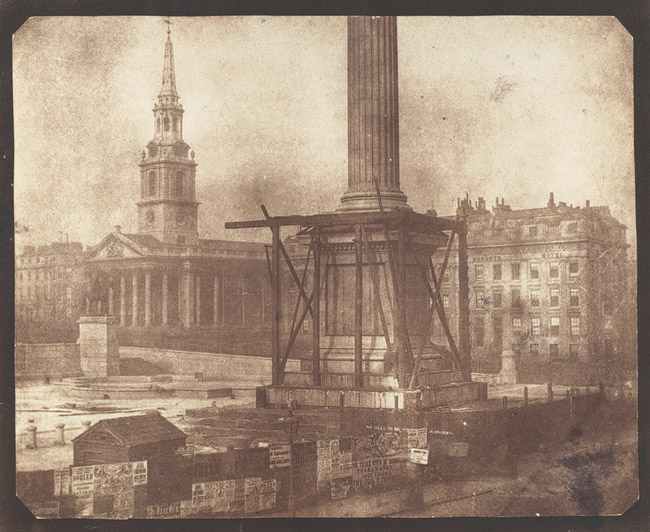Bryan ponders a ‘troubling dream’ of a photograph…
This is William Henry Fox Talbot’s Nelson’s Column under Construction, Trafalgar Square, April 1844. It is a photograph that has haunted me for some time.
The Met’s commentary says it ‘marks the beginning of a new, photographic way of seeing’ which, I think, is right. The composition is strange and unbalanced, containing St Martin-in-the-Fields, the raffish Morley’s Hotel and the column itself, startlingly cropped, in an uneasy spatial relationship. This is not just about getting everything in because, if that had been the intention, then the top of the column would have been included.
Perhaps, as the Met people say, it’s about ‘a fascinating intersection of the religious and secular, the historic and present-day’. But that sounds just too curatorish and falls far short of the eerie feeling I get from the picture. This, I now think, springs from the fact that the square is deserted, a fact made more poignant by the billboards which nobody is reading.
This could be a post-apocalyptic vision in which the scaffolding signals not work but abandonment. And that, combined with the soft, misty effects produced by Fox Talbot’s camera and paper, turns the whole thing into a troubling dream, if not a full blooded nightmare. Or, I suppose, it is just very early in the morning and the city is still sleeping. It remains a dream, but a more benign one.
Either way, it’s a great photograph, a moment of discovery, beyond which, almost 170 years later, few snappers have progressed.












perhaps it seems odd because something we think of as being so mightily solid and permanent and perfectly surfaced was once new and raw and erected with rickety scaffolding. So that an object that you associate with mighty pedigree was at one time in effect the same as all the flashy baubles and empty housing estates being thrown up around Dubai and Beijing
Perhaps the emptiness is a result of an extended exposure time. As far as I remember, the first photographers had to leave the film exposed for a long time (several minutes?), so anything that moved didn’t register. However it was made, it’s an eerie picture.
What Philip said and, from the position of the shadows, it seems to have been taken in the late afternoon; between 5 and 6ish.
I wonder to what extent the faded sepia tone creates, or at least significantly adds to, the sense of eerieness and that haunting quality to which Bryan refers? Would it possess those qualities to a much reduced extent if printed in black and white?
It is a quite fascinating photograph – so many questions.
These early cityscapes (?) often have that dream-like quality. I think they printed on writing paper at this time, which increases graininess. Hill & Adamson captured the Scott Monument under construction in a similar way. In this one it’s finished and the impression less dream-like, maybe more of the Dubai effect!
http://www.flickr.com/photos/nationalgalleries/3102960996/in/set-72157610901994870
AliB
I wonder if Fox Talbot gave much mind to the subject, Nelson’s Column. If he had, surely he would have come on a different, more interesting day, maybe documented it. Instead he came on a Sunday afternoon when they’d all but taken down the scaffolding. Maybe he was just interested in the photographic process, like anyone with a brand new camera, they’ll snap anything.
Here’s a document about scaffolding from institute of civil engineers, 1844. http://www.icevirtuallibrary.com/deliver/fulltext/imotp.1844.24545.pdf?itemId=/content/article/10.1680/imotp.1844.24545&mimeType=pdf
1964 it may have been, new years eve it most certainly was, bad winter, struggled up from Staplehurst, the A20 had been snow-bound, same cause as the recent stuff, Siberia. Started off early drinking in, you know, that Watney’s pub behind St Martins, the one frequented by the Post Office crowd, then taxied along to Wapping and the Prospect, full of braying donkeys so back west and Soho, some god-forsaken drinking hole. By this time our Aussie friends were wishing that they were back in bloody Kings Cross, stale, cold, tetchy, not really pissed, not really sober, not really. Work next day, no new years day holiday in those early Wilson years.
Into Trafalgar Square we moped, joining the desultory army, more donkeys, this time with wet legs, stood in the fountain like a flock of corduroyed storks. “Happy new year” said one of the donkeys, “too true” said Aussie Don then off we went, their place in Wimbledon, goulash, more Watneys, roll on death.
Tell you what Bryan, you think that the photo of Trafalgar Square haunts you, the real thing haunts me.